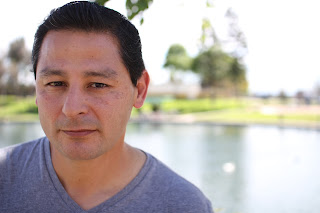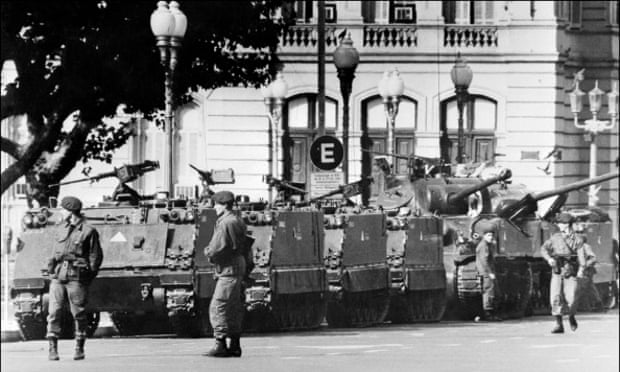To continue my post from 2 weeks ago...
Today marks the 40th anniversary of the military coup in Argentina. In 1976, a junta formed by commanders of the three branches of the Argentine military suspended constitutional order and instituted a government based on state violence and terror. This so-called "Proceso de Reorganización Nacional" (Process of National Reorganization) was hailed as a set of necessary measures to bring order and stability to a nation in crisis. The junta claimed itself as chief defender of Argentina's national and cultural interests, which they defined as conservative and Christian. It was those in power who defined their enemies as "subversive"--a wide term that encompassed not only those belonging to armed militant groups, but anyone whose ideas were critical of the regime or whose field of study or work was connected to social justice:
“A terrorist is not only someone with a weapon or a bomb,
but anyone who spreads ideas which are contrary to our Western and Christian
civilization.” -General
Videla

Today, we remember the 30,000 desaparecidos and honor their legacy by recognizing their activism, their voices of dissent in the presence of oppression.
We must also remember that, when the military took over on March 24, 1976, many Argentines sighed with relief. In their eyes, the new government would finally restore law and order and everything would be wonderful again.
“It wasn’t people who disappeared, but subversives.”
-General
Ramon Camps
UPDATE- Open Letter to President Obama: You can read
here the open letter to President Obama signed by professors of Argentine studies in the U.S. and abroad. The letter urged President Obama to meet with representatives of human rights organizations during his visit to Argentina and to help declassify documents that could shed light on crimes committed during the Proceso. In response to repeated requests from activists and human rights organizations, Obama's office announced last week that it would move to
declassify U.S. military and intelligence records related to Argentina's military dictatorship.
LECTURE- I'll be at the University of Iceland in
Reykjavík next week to speak about "Memorializing Disappearance in Argentina through Literary Testimonies" (Wednesday, 3/30). For more info:
http://bokmenntaborgin.is/en/events/memorializing-disappearance-argentina/
***
This Friday at the Bildner Center (NYC)
Politics and Aesthetics: Cuban Artists and Intellectuals,
1920-1952
Politics
and Aesthetics: Cuban Artists and Intellectuals, 1920-1952 - See more
at:
http://www.gc.cuny.edu/Page-Elements/Academics-Research-Centers-Initiatives/Centers-and-Institutes/Bildner-Center-for-Western-Hemisphere-Studies/Center-Events/Detail?id=34312#sthash.FJz24gxz.dpu
March 25, 2016: 4:00 PM-6:00 PM
365 Fifth Avenue Room# 9204
Between the Street and the Ivory Tower: Cuban Artists and
their Politics, 1940-1952.
Alejandro Anreus, William Paterson University
What were the politics of Cuba’s visual artists during the nation’s most
democratic years? These varied from the leftwing nationalism of the 1920s
generation to the apolitical elitism of the Orígenes group during the 1940s.
What did the artists associated with Nuestro Tiempo stood for in reaction to
the two previous generations? And how did they react to the end of
constitutional democracy with Batista’s coup? These and other issues will be
juxtaposed with definitions of pictorial styles and the sense of Cuban
identity.
'Social' in Context: 1916-1938
Ana María Hernández, LaGuardia Community College
The revista Social, founded in 1916 by Conrado Massaguer, had harbored
ambiguous aims from the start. On the one hand, it catered to the desire for
prominence of the emergent Cuban middle and upper classes that had become
enriched as a result of the rise in the price of sugar after World War I. On
the other, following the urgings of Emilio Roig de Leuchsenring, director of
the literary section of the magazine until its demise in 1938, it advanced
criteria and ideologies that undermined the hegemony of new elites. Social was
a unique blend of artistic vanguard and banality that encompassed social
chronicle, fashion, film reviews, various kinds of advertisements, and some of
the best poems and stories of its generation, as well as critical essays on
art, music and architecture. This introduction creates a context for the visual
and textual images to be presented by Vicki Gold Levi.
Art Deco in Cuba
Vicki Gold Levi, collector, curator and author, New York
Review of some of the iconic Art Deco graphics that appeared
in magazines, brochures and advertising, including the masterful works of
Conrado Massaguer.
Race, Art, and Social Thought in the Cuban Republic* (tentative title)
Mario Valero, Fashion Institute of Technology
Considering Cuban Counterpoint (1940) as a turning point in Fernando Ortiz’s
intellectual career, I would argue that some of Ortiz theoretical principles
governing his earlier criminological research on population control,
particularly those works aimed to produce a typology of Cuban crime, would
connect with his later anthropological work. Cultural specificities that
earlier stood up for strictly criminological material began in the 1940’s to be
presented as a source for cultural originality and nationalistic pride. As one
of the leading figures of the “Negritude” movement in Cuba, Ortiz promoted
afro-Cuban cultural production as a means of social integration, rather than
racial difference. Following this theoretical avenue, Ortiz insisted on a
“race-less” Cuban society, where racial differences would be reset through
cultural features.
Moderator: Ana María Hernández, LaGuardia Community College (to be confirmed)
***
LOOKING AHEAD Houston: April 27, 2016
Nuestra Palabra: Latino Writers Having Their Say
Makes History While We Save History #NP18
HOUSTON, TX - March 21, 2016 - As Nuestra Palabra: Latino Writers Having Their Say (NP) turns 18, it is not only saving history by making sure that the voice of the Latino community is heard, NP is also making History because the NP papers are now collected at the Houston Public Library.
"We may be the only Chican@, Latin@ literary group in the nation that can ensure that books by and about Latino authors are taught in the classroom, are discussed on the air, and are preserved in the library for future readers and scholars-all in the same day," said NP founder, writer, activist, and professor Tony Diaz, El Librotraficante. "We are also blessed with the knowledge that we are capable of this and the drive to do even more."
The Nuestra Palabra Collection is housed at the Houston Metropolitan Research Center, part of the Special Collections Division of the Houston Public Library System. The documents, newspapers and photographs in this collection tell the story of a Latino literary movement that began in Houston, Texas in 1998. Visit the Texas Room of the Julia Ideson Building at 550 McKinney Street to view the Nuestra Palabra Collection and other Hispanic Archival Collections. The Texas Room is open Mondays, Tuesdays, and Thursdays 10am to 6pm, Wednesdays 10am-8pm, and Saturdays 10am-5pm.
Celebrate the 18th anniversary of Nuestra Palabra.
Wednesday, April 27, 2016, 6pm - 8pm
Talento Bilingue de Houston 333. S. Jensen.
Tickets available at www.NuestraPalabra.org.
$25 at the door. $20 in advance.
$50 SuperTickets include guaranteed front row or reserved seating &
copies of NP author books.
 It's springtime in
Arizona. The temperature in more like early summer elsewhere. Lizards
with brand-new neon racing stripes skitter across the desert in search
of mates. The sunlight is rich and intense and makes the cactus
blooms and wildflowers look gorgeous.
It's springtime in
Arizona. The temperature in more like early summer elsewhere. Lizards
with brand-new neon racing stripes skitter across the desert in search
of mates. The sunlight is rich and intense and makes the cactus
blooms and wildflowers look gorgeous.































